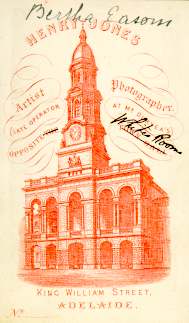 |
Henry
JONES
Left: Henry Jones occupied a studio opposite the Adelaide Town Hall when he
left Duryea and opened his own photographic business. This carte de visite would
have been made after he moved from his studio opposite the Town Hall to a new studio
opposite White's Assembly Rooms (see next illustration). This picture of the Adelaide Town
Hall was printed on the card mounts in black, red, blue and purple ink. |
Born in Bristol, Gloucestershire, England, in 1826, Henry Jones arrived
in Victoria in the late 1850s. In 1859 he was listed as a daguerrean and photographic
artist in Melbourne, and after working in other studios in Victoria he came to South
Australia in 1866.
From July 1866 to February 1868 Henry Jones was an operator at Townsend
Duryea’s studio in King William Street, Adelaide, but by September 1868 had his own
studio in King William Street, opposite the Town Hall. Here he made cartes de visite for
15s per dozen, extra copies 1s each; cabinet portraits for 30s per dozen; and carte de
visite copies of photographs, paintings or engravings for 12s per dozen. By July 1871 he
was making life-size portraits for £3 each.
At the fifteenth South Australian Society of Arts exhibition, held in
December 1871, Henry Jones was awarded a prize of one guinea for the best ‘eight
untouched carte de visite full-length portraits’, which were portraits of children.
By July 1876 he had named his business the Children’s Photographic Company, with a
minor change to Children’s Photograph Company by June 1879.
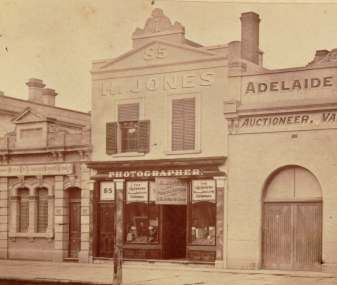 |
Left: Henry Jones’s studio opposite White’s Rooms. It
was at 85 King William Street, between Currie Street and Waymouth Street, Adelaide. His
sign says "The Childrens Photograph Company. Photographer to His Excellency the
Governor." In those days having Vice-Regal patronage added status to the studio. |
Henry Jones is perhaps best known for the two large mosaics he
assembled after the 1871 Old Colonists Banquet. On the 35th anniversary of the founding of
the colony of South Australia, 28 December 1871, Emanuel Solomon gave a banquet to 520 old
colonists in the Adelaide Town Hall. Solomon was a successful Adelaide merchant who had
come to South Australia from New South Wales in 1838, and the reason he gave for giving
the banquet was his desire, as an old pioneer, ‘to once more meet some of his old
associates.’ He asked all old colonists whose date of arrival was before 1841 to
forward their names to him so that he could extend a formal invitation to the banquet.
In March 1872 Henry Jones advertised that portraits of ‘the
gentlemen who had been invited to the Old Colonists Banquet’, which were to be
presented as a group to Mr Solomon, would continue being taken for one month after his new
studio opposite White’s Rooms had been opened. He was in his new studio by the middle
of April and in May announced that June 15 would be the last day for taking portraits of
the Old Colonist gentlemen, ‘after which the Lady Old Colonists would be invited to
sit for a companion group.’ Townsend Duryea also made a large mosaic of the male old
colonists in 1872, and Hammer & Co. commenced portrait-taking for another
similar mosaic in 1886.
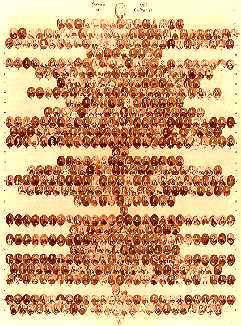 |
Left: Mosaic of South Australian Old Lady Colonists. On
23 July 1881 the Observer reported that Henry Jones had completed his mosaic of
656 portraits of the old lady colonists which he had started in June 1872. It had taken
nine years to complete and appears to have had more portraits added since the date of the Observer
report. |
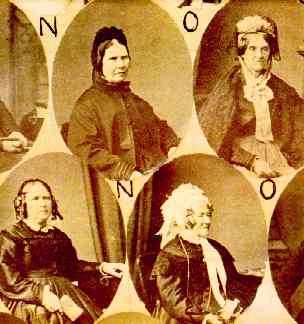 |
Left:
An enlarged section of Henry Jones’s mosaic of the Old Lady Colonists. |
While the portraits of the male Old Colonists appear to have been
finished and presented to Mr Solomon in reasonable time, the mosaic of lady Old Colonists
was not complete when Emanuel Solomon died in 1873. Almost ten years after the banquet was
held, the mosaic of ladies was finished. The Observer for 23 July 1881 reported,
‘On Wednesday we had an opportunity of inspecting a group of portraits of old lady
colonists. Mr H. Jones, of Wakefield Street, who is the possessor of the group, has been
nearly ten years in producing the whole, having taken the first in June 1872. The
portraits, which form a companion group to that completed some years ago of the old
gentleman colonists, have all been taken from life, and this fact naturally makes them
more valuable. There are altogether 656 of them, and having been well taken they will be
readily recognised by those who were acquainted with the originals. Unlike those which Mr
Jones formerly took, they are arranged in alphabetical order, and not according to the
length of time which the originals have been in the colony. In the case of Mrs Stephens,
who arrived in the colony by the first vessel in 1836, an additional portrait has been
taken, or rather more than double size, and placed at the head of the group. Mr Jones
certainly deserves great credit for the trouble he has taken in making this collection,
which, no doubt, hereafter will prove a valuable memento of those who were the pioneers of
the colony.’ The original mosaic is held by the Mortlock Library, North Terrace,
Adelaide.
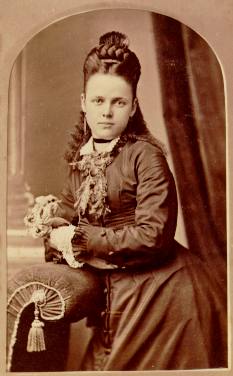 |
Left:
Carte de visite portrait by Henry Jones, "opposite White's Rooms", King William
Street, Adelaide. On the back of his card Jones advertised the fact that he had been
awarded the Society of Arts prize for portraits of children, and also that he had received
vice-regal patronage. He was trading under the name of The Childrens’ Photograph
Company. |
Although Henry Jones opened his new studio at 85 King William Street,
opposite White’s Rooms, in March or April 1872, he must have operated two studios at
some stage, as he had carte de visite mounts printed which showed both addresses,
‘opposite the Town Hall and opposite Whites Rooms.’ He also used an identical
design on another mount, but with only the ‘opposite White’s Rooms’ address
on it.
On 4 January 1877 Henry Jones received Vice-Regal patronage. His
Excellency Sir Anthony Musgrave, Governor of South Australia, was photographed in his
studio in both carte de visite and cabinet size. The Advertiser said, ‘The
likeness is a very faithful one. We have seen at the same establishment another likeness
of His Excellency in half-life size. The latter portrait is an enlargement of the
carte-de-visite, but the expression of the face in the larger portrait is not so good nor
so pleasant as that of the smaller one.’
By September 1880 Henry Jones had moved his Children’s Photograph
Company to Wakefield Street East, near Hutt Street, opposite Oliver’s Timber Yard.
The omnibus that passed his studio, he said, left the corner of Rundle Street and King
William Street every hour. By May 1881 the price of his cartes de visite had been reduced
to 7s 6d per dozen, extra cards 6d, and cabinets were 15s per dozen.
By January 1885 Henry Jones had moved the Children’s Photograph
Company to the northern corner of King William Street and Hindley Street, where he
occupied the studio that had been vacated by the Melbourne Photographic Company. However,
he did not stay long, and by 1886 the studio had been taken by R. Laming, and later by
Stump & Co. Henry Jones died on 18 October 1911, and was buried in the West Terrace
cemetery.
End.




